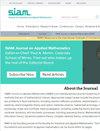A Novel Algebraic Approach to Time-Reversible Evolutionary Models
IF 2.1
4区 数学
Q1 MATHEMATICS, APPLIED
引用次数: 0
Abstract
SIAM Journal on Applied Mathematics, Volume 84, Issue 4, Page 1845-1867, August 2024.Abstract. In recent years, algebraic tools have been proven useful in phylogenetic reconstruction and model selection through the study of phylogenetic invariants. However, up to now, the models studied from an algebraic viewpoint are either too general or too restrictive (as group-based models with a uniform stationary distribution) to be used in practice. In this paper we provide a new framework to study time-reversible models, which are the most widely used by biologists. In our approach we consider algebraic time-reversible models on phylogenetic trees (as defined by Allman and Rhodes) and introduce a new inner product to make all transition matrices of the process diagonalizable through the same orthogonal eigenbasis. This framework generalizes the Fourier transform widely used to work with group-based models and recovers some of the well-known results. As illustration, we combine our technique with algebraic geometry tools to provide relevant phylogenetic invariants for trees evolving under the Tamura–Nei model of nucleotide substitution.
时间可逆进化模型的新代数方法
SIAM 应用数学杂志》,第 84 卷第 4 期,第 1845-1867 页,2024 年 8 月。 摘要近年来,通过对系统发育不变式的研究,代数工具已被证明在系统发育重建和模型选择中非常有用。然而,迄今为止,从代数角度研究的模型要么过于笼统,要么限制性太强(如具有均匀静态分布的基于群的模型),无法在实践中使用。在本文中,我们提供了一个研究时间可逆模型的新框架,这种模型是生物学家最广泛使用的模型。在我们的方法中,我们考虑了系统发育树上的代数时间可逆模型(由 Allman 和 Rhodes 定义),并引入了一种新的内积,使过程的所有过渡矩阵都能通过相同的正交特征基对角化。这一框架对广泛应用于基于群体模型的傅立叶变换进行了概括,并恢复了一些众所周知的结果。作为说明,我们将我们的技术与代数几何工具相结合,为核苷酸替换的田村-内模型下演化的树提供了相关的系统发育不变式。
本文章由计算机程序翻译,如有差异,请以英文原文为准。
求助全文
约1分钟内获得全文
求助全文
来源期刊
CiteScore
3.60
自引率
0.00%
发文量
79
审稿时长
12 months
期刊介绍:
SIAM Journal on Applied Mathematics (SIAP) is an interdisciplinary journal containing research articles that treat scientific problems using methods that are of mathematical interest. Appropriate subject areas include the physical, engineering, financial, and life sciences. Examples are problems in fluid mechanics, including reaction-diffusion problems, sedimentation, combustion, and transport theory; solid mechanics; elasticity; electromagnetic theory and optics; materials science; mathematical biology, including population dynamics, biomechanics, and physiology; linear and nonlinear wave propagation, including scattering theory and wave propagation in random media; inverse problems; nonlinear dynamics; and stochastic processes, including queueing theory. Mathematical techniques of interest include asymptotic methods, bifurcation theory, dynamical systems theory, complex network theory, computational methods, and probabilistic and statistical methods.

 求助内容:
求助内容: 应助结果提醒方式:
应助结果提醒方式:


